Key takeaways:
- Digitizing family records helps preserve memories, enhances accessibility, and facilitates the sharing of family history across generations.
- Key tools for digitization include high-quality scanners, photo management software, and cloud storage, which enhance organization and accessibility.
- Organizing digital archives by creating folders and adding metadata aids in easy retrieval and enhances collaborative efforts among family members.
- Regularly updating and choosing appropriate digital preservation formats are essential for maintaining the integrity and longevity of digitized records.

Understanding family record digitization
Digitizing family records is about more than just typing data into a computer; it involves preserving precious memories and connecting generations. I still remember the first time I scanned my grandmother’s handwritten recipes. The joy of seeing her familiar handwriting transformed into a digital format brought back memories of our family gatherings. Have you experienced that rush of nostalgia when looking through old photos or letters?
The process of digitization can also bring to light aspects of our family history that may have been forgotten. As I delved into my family’s archives, I stumbled across letters my great-grandparents wrote to each other during the war. Each word held a story, a glimpse into their challenges and triumphs. Isn’t it fascinating how one digital file can hold the collective memories of our ancestors?
Understanding the nuances of digitization is crucial—it’s not just about getting things online, but also ensuring the quality and longevity of those records. I learned the hard way that not all formats maintain their integrity over time. Choosing the right format for photographs versus documents can feel overwhelming, but it’s essential to approach it with care. Have you considered how to best preserve your family’s unique stories for future generations?
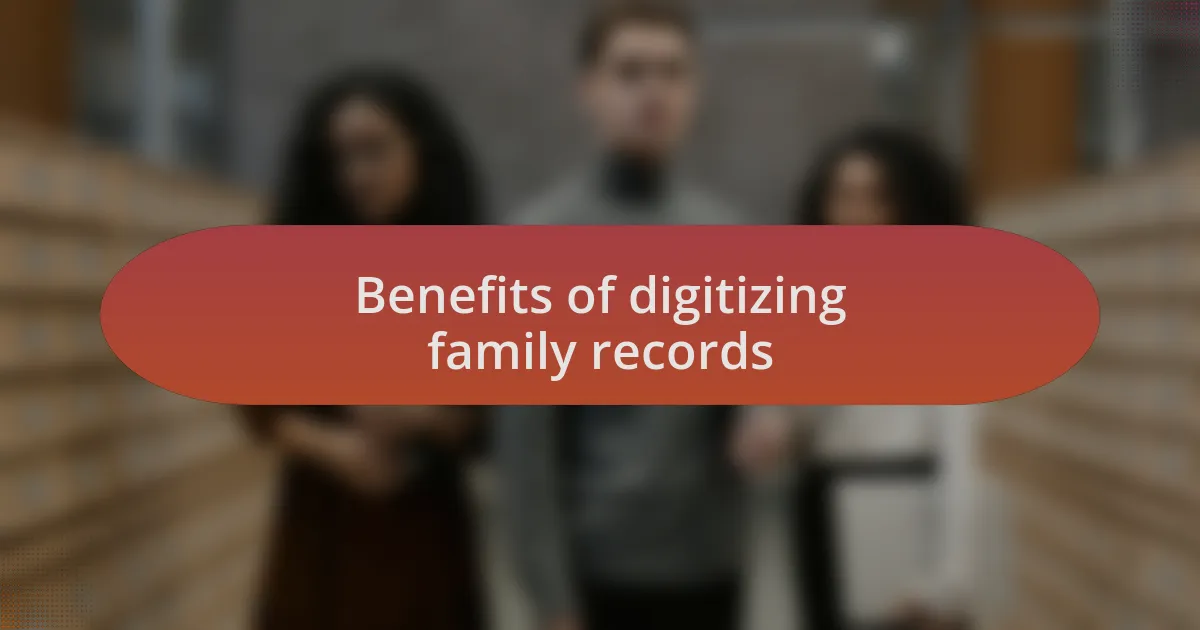
Benefits of digitizing family records
One major benefit of digitizing family records is the accessibility it provides. I vividly remember the thrill of being able to pull up my childhood photos on my tablet while reminiscing with family over dinner. Gone are the days of sorting through dusty boxes in the attic when everything is just a few clicks away. Doesn’t it feel liberating to access decades of memories in an instant?
Another significant advantage is the preservation of family history. I once discovered an old family tree that had been meticulously crafted by my grandmother, but it was fading fast. By digitizing it, not only did I save it from deterioration, but I also ensured the lineage could be shared easily with younger family members. How empowering is it to know that our stories will live on beyond immediate family confines?
Moreover, digitization allows for easy sharing and collaboration among relatives. In one instance, I created a shared online folder with my cousins where we could all contribute photos and documents. This collaborative effort not only deepened our connections but sparked conversations about our family’s past that we may not have had otherwise. Isn’t it exciting to think how many new stories can emerge when everyone contributes their pieces of the puzzle?
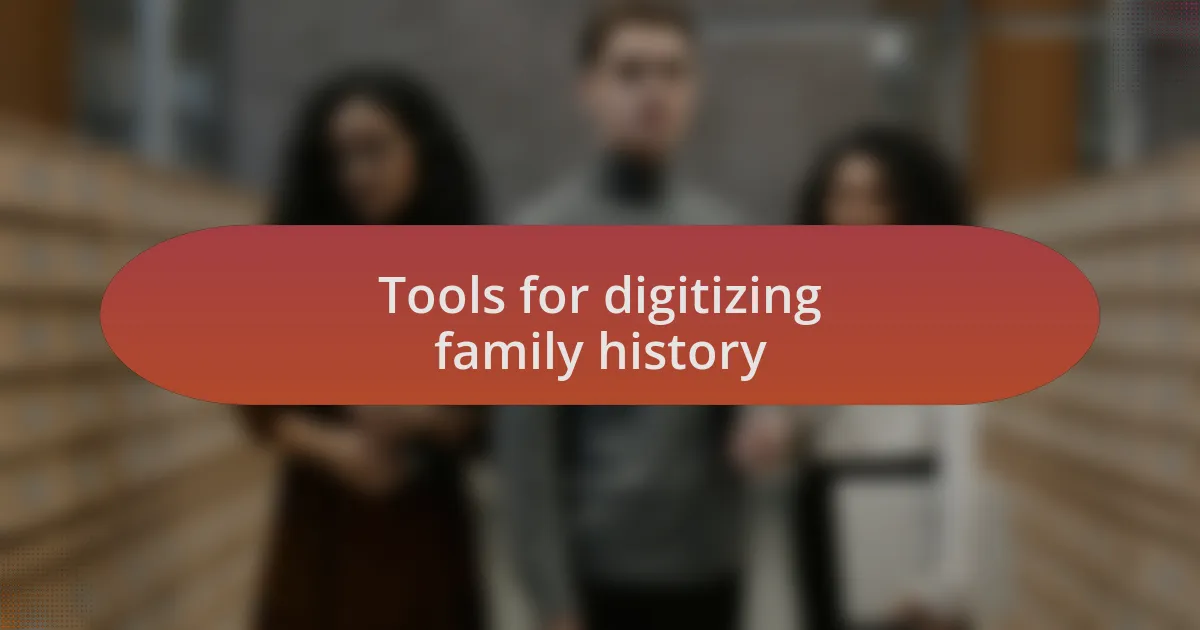
Tools for digitizing family history
When it comes to tools for digitizing family history, I found that using a high-quality scanner made a world of difference. I often relied on my flatbed scanner for photographs and documents, but I also discovered portable options that transformed how I captured items on the go. The excitement of using a handheld scanner at my grandmother’s house to digitize her treasured letters was unforgettable. Have you ever felt the rush of preserving a cherished memory in real-time?
Another tool that’s played a pivotal role for me is photo management software. After digitizing my family records, I began organizing everything with programs that allowed me to tag and categorize images efficiently. I distinctly remember spending hours sorting through years of memories, and suddenly I was able to access birthdays, weddings, and family reunions in an organized timeline—almost like flipping through a well-curated album. Isn’t it rewarding when technology enhances the storytelling aspect of our family histories?
Don’t underestimate the power of cloud storage, either. Once I took the plunge and migrated my digitized records online, I felt a tremendous sense of peace. I could share these documents with family members living far away, allowing them to contribute their insights and stories. Knowing that my family’s history is safely backed up and easily accessible at any time brings immense satisfaction. Have you thought about how secure your family records are?
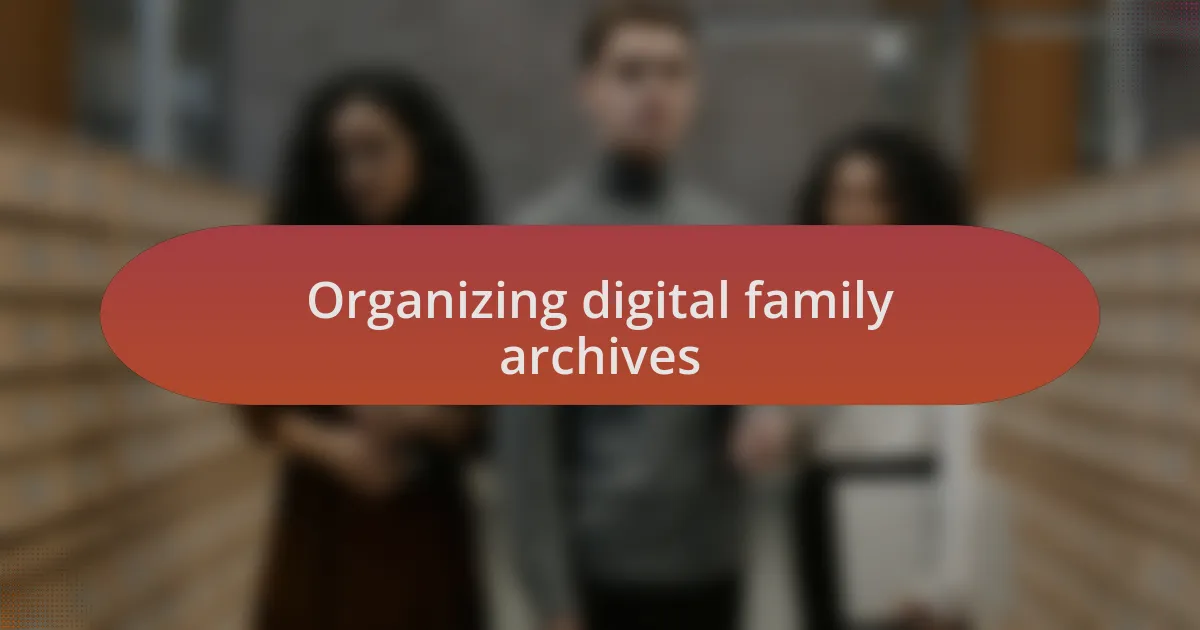
Organizing digital family archives
Organizing my digital family archives became an adventure that required some thoughtful strategies. I remember one afternoon when I decided to tackle the mountain of files I had accumulated. I created folders by family branches, and I felt an immense sense of achievement as I watched my screen transform into a neatly organized library of our history. Have you ever experienced that joy of order amidst chaos?
Beyond mere folders, I discovered the usefulness of adding metadata to my files. By tagging names, dates, and locations, I made it easier for myself to search for specific memories later on. I vividly recall the moment I found a photograph of my great-grandparents’ wedding day, something I hadn’t seen in years, just by typing their names into a search bar. Isn’t it incredible how a little organization opens the door to so many stories waiting to be rediscovered?
As I continued to organize my archives, I felt compelled to share my progress with family members. I set up a shared drive, inviting relatives to contribute their own documents, photos, and stories. The collaboration made my heart swell, as I realized that preserving our family history wasn’t just my task; it was a collective journey. Have you thought about how collaboration could enrich your family documentation efforts?
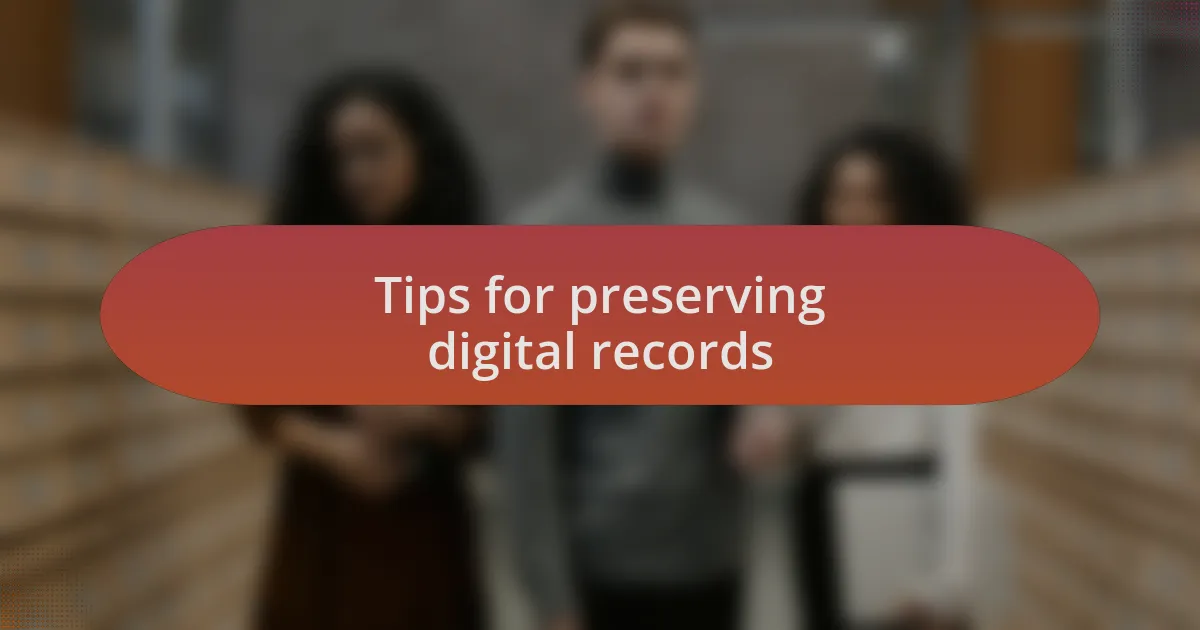
Tips for preserving digital records
To effectively preserve digital records, it’s essential to choose reliable storage solutions. When I first digitized my family records, I used a combination of external hard drives and cloud storage. I remember the moment I breathed a sigh of relief knowing that even if my home faced a disaster, my family’s history was safe in multiple locations. Have you considered how critical it is to have a backup plan for your precious memories?
Regularly updating and refreshing your stored files is another crucial step. I often find myself revisiting old folders and checking for file integrity, even replacing images that have become outdated in quality. There’s a certain peace of mind in knowing that the digital versions of my ancestors are not only preserved but also presented in the best possible light. How often do you think about revising your digital archives to keep them current and appealing?
Lastly, don’t forget about digital preservation formats. When I learned about the differences between JPEG, TIFF, and other formats, it felt like unlocking a new layer of understanding about how my files would age over time. For instance, I now save high-resolution scans of important documents in TIFF format for archival purposes, knowing that they won’t degrade over time. What formats are you currently using, and have you considered how they might affect the longevity of your family records?
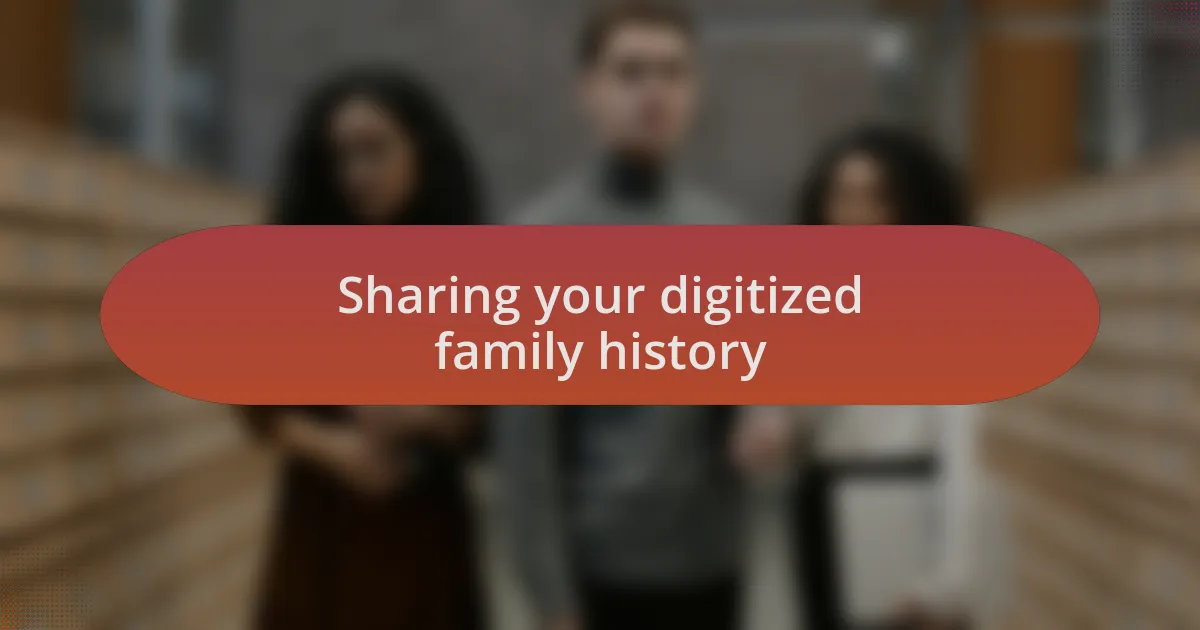
Sharing your digitized family history
Sharing your digitized family history can be a rewarding experience. I remember the first time I shared my family tree online with distant relatives. It felt like opening a door to connections I never knew existed, as they began to share their own stories and photographs, enriching our shared history. Have you thought about the far-reaching impact of sharing your family narratives?
Social media platforms offer a unique opportunity to connect with others who share your passion for genealogy. When I created a dedicated page for my family’s history, it was thrilling to see comments and interactions from others who recognized familiar names or places. This sense of community can be incredibly uplifting, pushing me to delve deeper into my research. What platforms do you think might work best for your family history sharing?
Don’t overlook the value of family gatherings to showcase what you’ve discovered. Last summer, I set up a small display at our family reunion featuring digitized photos and documents. Watching my relatives reminisce and recount their memories related to those images was a beautiful reminder of why I embarked on this journey. Have you considered how sharing these moments could not only preserve our family’s legacy but also strengthen the bonds between generations?